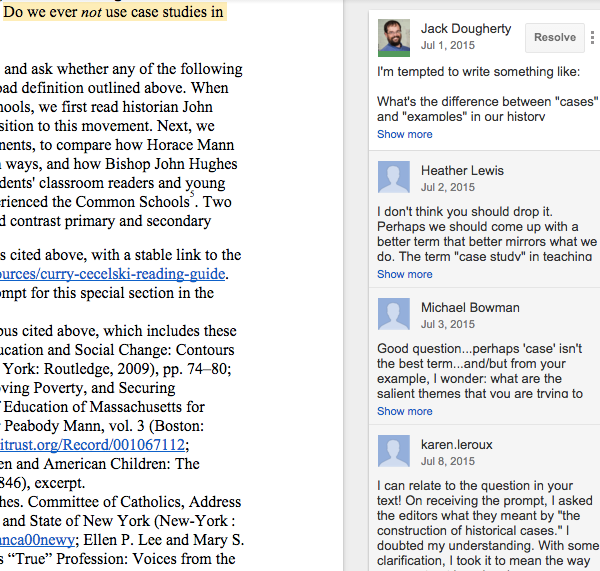In Spring 2015, Nancy Beadie and Joy Williamson-Lott, as incoming editors of the History of Education Quarterly, invited me and eight other colleagues to contribute essays for one of their new formats: a teaching forum. Their goal is to spark deeper reflections about our pedagogical thinking in the pages of this scholarly journal, which in past years has published mostly conventional research articles. The editors prompted us with a question — how do we teach history with case studies? — and pushed us to think about it as broadly as possible.
It wasn’t hard to persuade me to participate. I consider teaching to be central to my work, an intellectual exercise in pairing insightful questions with historical sources, closely watching and listening to how students learn, and continually rethinking the process for the next semester. But this group essay assignment also provided an opportunity to rethink how faculty engage in our work as writers. In the traditional mode, we submit our individual essays to editors, without necessarily see or having an opportunity to respond to what other authors are crafting for the same section. Yet this time, the HEQ editors accepted a suggested alternative: to encourage all of the contributors to share our drafts-in-progress in a Google Documents digital folder. This arrangement allowed each of our individual essays to benefit with constructive comments by our peers, and it also created more coherent conversation across our collective works. The key was to insert peer commentary into the middle of our writing process, rather than a traditional review of polished pieces at the end stage, to maximize the value of our feedback to one another.
The best way to understand this HEQ draft commentary process is to reveal the behind-the-scenes process, months before we arrived at the finished product. The examples pictured below feature comments that peers posted on different stages of my writing, because I am the “owner” of these digital drafts, and changed the sharing settings from private to public. I emailed my peers to ask if any wished to delete their comments on my public essay, and no one did. But I do not link to other drafts written by my peers, where many more comments appear, because they own their drafts, not me. If other forum participants wish to do so, they also can make their drafts public, share links and/or screenshots online, or ask me to include them in this essay.
The first draft I shared with the group appeared in this June 2015 Google Document. Looking back, my writing was still in the discovery process. I began by describing a case study comparison in my class — an old one that I had written about elsewhere — but was still searching for the best way to express a new idea that had popped into my head. A few paragraphs into the essay, I rhetorically asked, “Do we ever not use case studies in our history teaching?” My inner skeptic had begun to challenge the writing prompt given to us by the editors, by questioning whether it was impossible to teach history without cases of some type. When we began to comment on each other’s drafts in early July, I noted my temptation to develop this theme further. Three other authors — Heather Lewis, Michael Bowman, and Karen Leroux — offered encouragement and constructive feedback, which shifted my approach. If they thought this half-baked idea had merit, perhaps I should frame it into a thesis and restructure the entire essay. Midway through the writing process, my peers inspired me to rethink and revise.
 Excerpt of my first draft with peer comments, from my June 2015 Google Doc
Excerpt of my first draft with peer comments, from my June 2015 Google Doc
A week later I rewrote the essay and shared it with the group in this July 2015 Google Document. This newer version began with a stronger introductory argument and framework for four sections that followed about different types of cases in history teaching. But in this second round of commentary, my colleagues drew attention to some of my uncertain wording in the body of the essay, particularly the fourth section. When historians teach with role-playing scenarios, such as the highly-praised and widely popular “Reacting to the Past” series, does it favor conflict and competition over empathy and understanding? But that question wasn’t fully developed at the time. In this draft, authors Jon Hale, Ansley Erickson, and Isaac Gottesman posted comments that nudged me to clarify my not-yet-formed internal thoughts into clearer prose that others would understand. For authors who are stuck inside our own heads — something that happens to me quite often — their feedback allowed me to re-read my essay through their eyes, and re-word sentences to communicate more clearly.
 Excerpt of my second draft with peer comments, from this July 2015 Google Doc
Excerpt of my second draft with peer comments, from this July 2015 Google Doc
No doubt, the last draft that I submitted in this final August 2015 Google Document is much stronger than what initially appeared months earlier on my computer screen. But the difference is that I received substantive peer feedback during my writing process, rather than solely at the end, when it’s often too late to significantly restructure and revise. Moreover, my essay became more refined and interconnected with the thinking of other authors because they shared their drafts and welcomed comments at the same time when I was writing and revising mine.
Memo to academic journal editors: If you want scholars to break out of our individual silos and communicate beyond our areas of specialization, then create more interdependent writing and commenting forums such as this one. Also, a memo to historians and other scholars: If the idea of sharing your drafts-in-progress with many colleagues sounds strange to you, then you need to get out of your office more often. Visit more classrooms, from kindergarten through college, that emphasize collaborative writing and peer editing. Read some of the ideas, examples, and tutorials featured in an open-access volume of essays I co-edited with Tennyson O’Donnell, Web Writing: Why and How for Liberal Arts Teaching and Learning (University of Michigan Press, 2015), or a related volume Writing History in the Digital Age, co-edited with Kristen Nawrotzki (University of Michigan Press, 2013). Try teaching by assigning short essays where students have compelling reasons to share drafts and peer edit one another. Remember that technology is not the end goal, but rather, a tool that can help to restructure our traditionally isolated ways of writing in both teaching and scholarship.
If you want to read the full set of Teaching Forum essays, you’ll need to go to the February 2016 issue of the History of Education Quarterly. Unfortunately, HEQ is published through a proprietary press with a subscriber-only site. At my campus, readers may need to log in through this HEQ ezproxy.trincoll.edu link, which requires a Trinity College username and password. Alas, HEQ does not yet belong to the growing number of open-access scholarly journals. Although my colleagues and I performed the bulk of the labor by writing and commenting on each other’s essays, the proprietary press makes a profit by selling our words, primarily back to our own non-profit academic institutions and our financially struggling libraries. But that’s a different rant, which I’ll save for another time . . .
